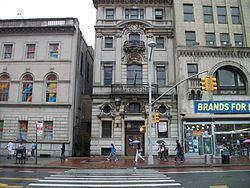Built 1897 Designated NYCL February 12, 2008 | NRHP Reference # 83001774 Opened 1897 Added to NRHP 19 May 1983 | |
 | ||
Similar La Casina, Jamaica Chamber of Comm, Grace Episcopal Church C, First Reformed Church, King Manor | ||
Landmarked 116 year old jamaica savings bank building set for transformation
The Jamaica Savings Bank building, located in the Jamaica section of the borough of Queens in New York City, was built between 1897 and 1898 in the Beaux-Arts style. It is a slender four story brick building with a limestone facade. It features a deeply rusticated ground floor with windows protected by elegant metal grilles. The facade is framed by double-story pilasters and covered with elaborate carved brackets, swags and other elements.
Contents
History
The original Jamaica Savings Bank was incorporated on April 20, 1866 by 19 local business leaders, including John Alsop King, governor of New York (1857-1858); Morris Fosdick, and Colonel Aaron A. Degrauw, who met in the Jamaica Town Hall in an effort to "pool their local resources for the purpose of protecting their savings and financing future development" of the Jamaica area. The bank officially opened to the public on July 14, 1866 at 161-02 Jamaica Avenue - a year after the civil war - and operated out of the Queens County Clerk's office with 15 customers depositing a total of $2,675.00. To supplement the ever-expanding community of Jamaica, the bank trustees hired the architectural firm of Hough and Deuell to build the new Beaux-Arts style bank headquarters that became flagship building of the Jamaica Savings Bank in 1898. "This building conveyed the kind of monumentality that is often associated with private social clubs and civic institutions."
With the advent of the railroad and other transportation systems, Jamaica quickly developed into the economical and commercial hub of Queens County throughout the early-twentieth century. To fulfill the economic needs of Jamaica's rapidly expanding population, the President of the Jamaica Savings Bank, George S. Downing, felt that the creation of more bank branches was necessary. In December 1934, the Queensboro Savings Bank (located at 90-55 Sutphin Boulevard) was merged with the Jamaica Savings Bank. As a result, the Queensboro Savings Bank was henceforth known as the Jamaica Savings Bank; the bank with the Jamaica Avenue address became the Main Office of the company and the Sutphin Boulevard address served as the Branch Office. The employees of the Queensboro Savings Bank all retained their positions but were then considered employees of the Jamaica Savings Bank.
In 1934, Jamaica Savings Bank had a total of 50,614 accountants and was listed as fifty-seventh among the 100 largest savings banks in the United States. The officers of the Jamaica Savings Bank at that time were George S. Downing, president; Supreme Court Justice Leander B. Faber, Robert W. Higbie and George K. Meynen, vice-presidents; Charles R. Doughty, treasurer; G. Warren Smith, secretary, and Richard W. Reeves, assistant secretary.
On August 27, 1938, George S. Downing announced that the construction of the second Jamaica Savings Bank branch was underway and was expected to be completed on February 1, 1939. Downing stated that the "decision to construct the building had been precipitated by the rapid grown of the Jamaica area" and that the "extension of the Eighth Avenue subway line to Jamaica had resulted in a 'phenomenal growth of apartments' in that section." The Sutphin Boulevard Branch of the Jamaica Savings Bank officially opened on April 22, 1939 and was designed by Architect Morrell Smith of 475 Fifth Avenue and Builder/General Contractor Theodore L. Rubsamen and Company of Jamaica. This unique art deco building featured striking decorative features; its most notable feature being the American eagle carved in a low relief and placed over the entrance. "Ornamental cast bronze doors grace the entrance which opens upon a semicircular vestibule lined with marble of black and gold...Furnishings in American walnut, bronze lighting fixtures...and carpets of and draperies of harmonious design and hue complete the interior.
The legacy of the Jamaica Savings Bank lasted for nearly a century until the bank was acquired by North Fork Bank in 1999, which itself was acquired by Capital One Bank in 2008. As of this writing, the Sutphin Boulevard branch of the Jamaica Savings Bank building is a Capital One Bank branch. The original Jamaica Savings Bank building was listed on the National Register of Historic Places in 1983, and a New York City Landmark in 2008. The second branch building on Sutphin Boulevard was dedicated as a New York City Landmark in 2010.
